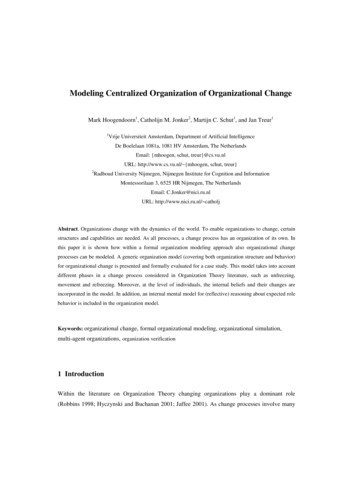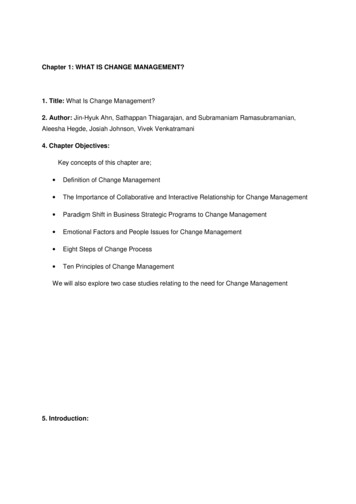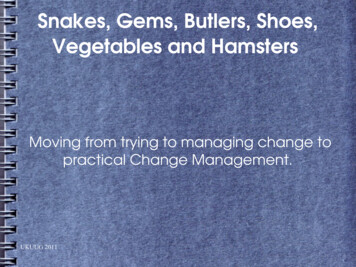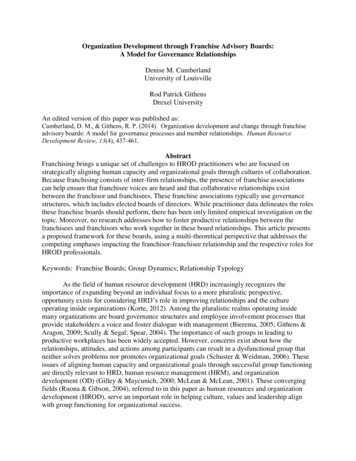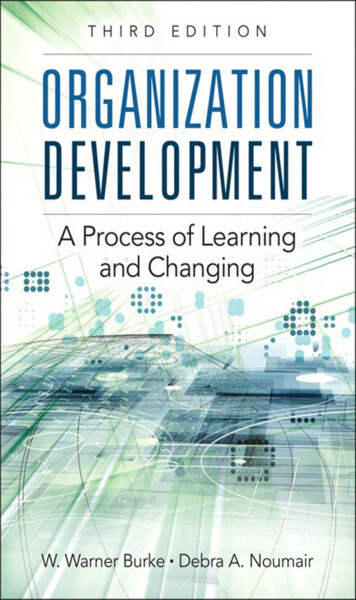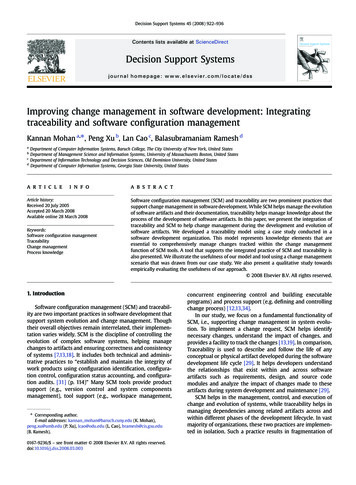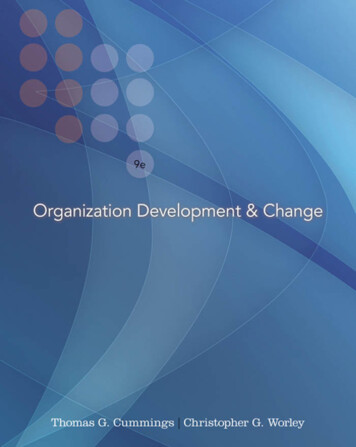
Transcription
9eOrganization Development & ChangeThomas G. CummingsUniversity of Southern CaliforniaChristopher G. WorleyUniversity of Southern CaliforniaPepperdine UniversityAustralia Brazil Canada Mexico Singapore Spain UnitedKingdom UnitedStates
Organization Development & Change,9th EditionThomas G. Cummings &Christopher G. WorleyVice President of Editorial, Business:Jack W. Calhoun 2009, 2005 South-Western, a part of Cengage LearningALL RIGHTS RESERVED. No part of this work covered by the copyrighthereon may be reproduced or used in any form or by any means—graphic, electronic, or mechanical, including photocopying, recording,taping, Web distribution, information storage and retrieval systems, orin any other manner—except as may be permitted by the license termsherein.Vice President/Editor-in-Chief: Melissa AcuñaExecutive Editor: Joe SabatinoDevelopmental Editor: Denise SimonMarketing Manager: Clint KernenContent Project Manager: D. Jean ButtromManager of Technology, Editorial: John BaransFor product information and technology assistance, contact us atCengage Learning Customer & Sales Support, 1-800-354-9706For permission to use material from this text or product,submit all requests online at www.cengage.com/permissionsFurther permissions questions can be emailed topermissionrequest@cengage.comMedia Editor: Rob EllingtonWebsite Project Manager: Brian CourterFrontlist Buyer, Manufacturing: Doug WilkeProduction Service: Integra Software Services,Pvt., Ltd.Sr. Art Director: Tippy McIntoshCover and Internal Designer: Mike Stratton,Stratton DesignCover Image: Chad Baker, Getty ImagesExamView is a registered trademark of eInstruction Corp. Windows isa registered trademark of the Microsoft Corporation used herein underlicense. Macintosh and Power Macintosh are registered trademarks ofApple Computer, Inc. used herein under license. 2008 Cengage Learning. All Rights Reserved.Library of Congress Control Number: 1234567890Student Edition ISBN 13: 978-0-324-42138-5Student Edition ISBN 10: 0-324-42138-9Instructor’s Edition ISBN 13: 978-0-324-58054-9Instructor’s Edition ISBN 10: 0-324-58058-1South-Western Cengage Learning5191 Natorp BoulevardMason, OH 45040USACengage Learning products are represented in Canada byNelson Education, Ltd.For your course and learning solutions, visit academic.cengage.comPurchase any of our products at your local college store or at ourpreferred online store www.ichapters.comPrinted in Canada1 2 3 4 5 6 7 12 11 10 09 08
DedicationTo Chailin and Debbie, the loves of our lives
brief contentsPrefaceCHAPTER 1General Introduction to OrganizationDevelopmentPART 1Overview of Organization DevelopmentCHAPTER 2The Nature of Planned ChangeCHAPTER 3The Organization DevelopmentPractitionerPART 2The Process of Organization Development122CHAPTER 14Restructuring Organizations315CHAPTER 15Employee Involvement350CHAPTER 16Work Design376PART 5Human Resource ManagementInterventions41946CHAPTER 17Performance Management42074CHAPTER 18Developing Talent451CHAPTER 19Managing Workforce Diversityand Wellness47323CHAPTER 4Entering and Contracting75CHAPTER 5Diagnosing Organizations87CHAPTER 6Diagnosing Groups and Jobs107PART 6Strategic Change Interventions504CHAPTER 20Transformational Change505CHAPTER 7Collecting and Analyzing DiagnosticInformation121CHAPTER 21Continuous Change535CHAPTER 8Feeding Back Diagnostic Information139CHAPTER 22Transorganizational Change561CHAPTER 9Designing Interventions151CHAPTER 10Leading and Managing Change163CHAPTER 11Evaluating and InstitutionalizingOrganization Development Interventions189PART 3Human Process Interventions252CHAPTER 12Interpersonal and Group ProcessApproaches253CHAPTER 13Organization Process Approaches276PART 4Technostructural Interventionsivxv314PART 7Special Applications of OrganizationDevelopmentCHAPTER 23Organization Development in GlobalSettings613614CHAPTER 24Organization Development in NonindustrialSettings: Health Care, School Systems, thePublic Sector, and Family-Owned Businesses 651CHAPTER 25Future Directions in OrganizationDevelopment693Glossary746Name Index756Subject Index760
contentsPrefacexvCHAPTER 1General Introduction to Organization Development1Organization Development Defined1The Growth and Relevance of Organization Development4A Short History of Organization DevelopmentLaboratory Training BackgroundAction Research and Survey Feedback BackgroundNormative BackgroundProductivity and Quality-of-Work-Life BackgroundStrategic Change Background66891112Evolution in Organization Development12Overview of The Book14Summary17Notes17PART 1Overview of OrganizationDevelopmentCHAPTER 2The Nature of Planned Change2223Theories of Planned ChangeLewin’s Change ModelAction Research ModelThe Positive ModelComparisons of Change Models2323242729General Model of Planned ChangeEntering and ContractingDiagnosingPlanning and Implementing ChangeEvaluating and Institutionalizing Change2929303031Different Types of Planned ChangeMagnitude of Change3131Application 2-1 Planned Change at the San Diego CountyRegional Airport AuthorityDegree of Organization3235Application 2-2 Planned Change in an Underorganized SystemDomestic vs. International Settings3740Critique of Planned ChangeConceptualization of Planned ChangePractice of Planned Change414142Summary43Notes44v
viContentsCHAPTER 3The Organization Development Practitioner46Who is the Organization Development Practitioner?46Competencies of an Effective Organization Development Practitioner48The Professional Organization Development PractitionerRole of Organization Development Professionals5353Application 3-1 Personal Views of the Internal and ExternalConsulting PositionsCareers of Organization Development Professionals5659Professional Values60Professional EthicsEthical GuidelinesEthical Dilemmas616162Application 3-2 Kindred Todd and the Ethics of OD65Summary66Notes67Appendix70PART 2The Process of Organization DevelopmentCHAPTER 4Entering and Contracting7475Entering into an OD RelationshipClarifying the Organizational IssueDetermining the Relevant ClientSelecting an OD Practitioner76767677Developing a ContractMutual Expectations7979Application 4-1 Entering Alegent HealthTime and ResourcesGround Rules808181Interpersonal Process Issues in Entering and Contracting81Application 4-2 Contracting with Alegent Health82Summary86Notes86CHAPTER 5Diagnosing Organizations87What is Diagnosis?87The Need for Diagnostic Models88Open Systems ModelOrganizations as Open SystemsDiagnosing Organizational Systems898992Organization-Level DiagnosisOrganization Environments and InputsDesign ication 5-1 Steinway’s Strategic Orientation100Summary105Notes105
viiContentsCHAPTER 6Diagnosing Groups and Jobs107Group-Level DiagnosisInputsDesign lication 6-1 Top-Management Team at Ortiv Glass Corporation111Individual-Level DiagnosisInputsDesign ComponentsFitsAnalysis113113114115115Application 6-2 Job Design at Pepperdine University116Summary119Notes120CHAPTER 7Collecting and Analyzing Diagnostic Information121The Diagnostic Relationship121Methods for Collecting e Measures123124126127128Sampling129Techniques for Analyzing DataQualitative Tools130130Application 7-1 Collecting and Analyzing Diagnostic Data at Alegent HealthQuantitative Tools132133Summary137Notes138CHAPTER 8Feeding Back Diagnostic InformationDetermining the Content of the Feedback139139Characteristics of the Feedback Process141Survey FeedbackWhat Are the Steps?142142Application 8-1 Training OD Practitioners in Data FeedbackSurvey Feedback and Organizational Dependencies143145Application 8-2 Operations Review and Survey Feedback atPrudential Real Estate AffiliatesLimitations of Survey FeedbackResults of Survey Feedback146147148Summary149Notes149CHAPTER 9Designing Interventions151What are Effective Interventions?151How to Design Effective InterventionsContingencies Related to the Change SituationContingencies Related to the Target of Change152152154
viiiContentsOverview of InterventionsHuman Process Interventions156156Summary161Notes162CHAPTER 10Leading and Managing Change163Overview of Change Activities163Motivating ChangeCreating Readiness for ChangeOvercoming Resistance to Change165165166Application 10-1 Motivating Change in the Sexual Violence PreventionUnit of Minnesota’s Health Department168Creating a VisionDescribing the Core IdeologyConstructing the Envisioned Future169170171Developing Political Support171Application 10-2 Creating a Vision at PremierAssessing Change Agent PowerIdentifying Key StakeholdersInfluencing Stakeholders172174175175Managing the Transition176Application 10-3 Developing Political Support for the StrategicPlanning Project in the Sexual Violence Prevention UnitActivity PlanningCommitment PlanningChange-Management StructuresLearning Processes177178179179179Sustaining Momentum180Application 10-4 Transition Management in the HP–Compaq AcquisitionProviding Resources for ChangeBuilding a Support System for Change AgentsDeveloping New Competencies and SkillsReinforcing New BehaviorsStaying the ion 10-5 Sustaining Transformational Change atthe Veterans Health Administration187CHAPTER 11Evaluating and Institutionalizing OrganizationDevelopment Interventions189Evaluating Organization Development InterventionsImplementation and Evaluation FeedbackMeasurementResearch Design189189192197Institutionalizing Organizational ChangesInstitutionalization Framework200200Application 11-1 Evaluating Change at Alegent HealthOrganization CharacteristicsIntervention CharacteristicsInstitutionalization ProcessesIndicators of Institutionalization201203204205206Application 11-2 Institutionalizing Structural Change at Hewlett-Packard208Summary210
ixContentsNotes210Selected CasesKenworth MotorsPeppercorn DiningSunflower IncorporatedInitiating Change in the Manufacturing and Distribution Division of PolyProdEvaluating the Change Agent Program at Siemens Nixdorf (A)212212217239241247PART 3Human Process InterventionsCHAPTER 12Interpersonal and Group Process Approaches252253Process ConsultationGroup ProcessBasic Process InterventionsResults of Process Consultation253254255257Application 12-1 Process Consultation at Action Company258Third-Party InterventionsAn Episodic Model of ConflictFacilitating the Conflict Resolution Process259260261Application 12-2 Conflict Management at Balt Healthcare Corporation262Team BuildingTeam-Building ActivitiesActivities Relevant to One or More IndividualsActivities Oriented to the Group’s Operation and BehaviorActivities Affecting the Group’s Relationship with the Restof the Organization263264267268Application 12-3 Building the Executive Team at Caesars TahoeThe Manager’s Role in Team BuildingThe Results of Team Building269270271Summary273Notes273CHAPTER 13Organization Process Approaches268276Organization Confrontation MeetingApplication StagesResults of Confrontation Meetings276276277Application 13-1 A Work-Out Meeting at GeneralElectric Medical Systems Business278Intergroup Relations InterventionsMicrocosm GroupsApplication StagesResolving Intergroup Conflict279279280281Large-Group Interventions284Application 13-2 Improving Intergroup Relationshipsin Johnson & Johnson’s Drug Evaluation DepartmentApplication Stages285287Application 13-3 Using the Decision Accelerator to GenerateInnovative Strategies in Alegent’s Women’s and Children’s Service LineResults of Large-Group Interventions290294Summary295Notes295Selected CasesLincoln Hospital: Third-Party InterventionBen & Jerry’s (A): Team Development Intervention297297304
xContentsPART 4Technostructural Interventions314CHAPTER 14Restructuring Organizations315Structural DesignThe Functional StructureThe Divisional StructureThe Matrix StructureThe Process StructureThe Customer-Centric Structure315316318319322324Application 14-1 Healthways’ Process StructureThe Network Structure325328Downsizing331Application 14-2 Amazon.com’s Network StructureApplication StagesResults of Downsizing332334337Application 14-3 Strategic Downsizing at Agilent Technologies338ReengineeringApplication Stages340341Application 14-4 Honeywell IAC’s Totalplant Reengineering ProcessResults from Reengineering344346Summary346Notes347CHAPTER 15Employee Involvement350Employee Involvement: What Is It?A Working Definition of Employee InvolvementThe Diffusion of Employee Involvement PracticesHow Employee Involvement Affects Productivity350351352352Employee Involvement ApplicationsParallel Structures354354Application 15-1 Using the AI Summit to BuildUnion–Management Relations at Roadway ExpressTotal Quality Management356359Application 15-2 Six-Sigma Success Story at GE FinancialHigh-Involvement Organizations365367Application 15-3 Building a High-Involvement Organizationat Air Products and Chemicals, Inc.370Summary373Notes373CHAPTER 16Work Design376The Engineering Approach376The Motivational ApproachThe Core Dimensions of JobsIndividual DifferencesApplication StagesBarriers to Job Enrichment377378379380382Application 16-1 Enriching Jobs at the Hartford’s EmployeeRelations Consulting Services GroupResults of Job Enrichment383385The Sociotechnical Systems ApproachConceptual BackgroundSelf-Managed Work Teams386387388
xiContentsApplication StagesResults of Self-Managed Teams391393Application 16-2 Moving to Self-Managed Teams at ABB394Designing Work for Technical and Personal NeedsTechnical FactorsPersonal-Need FactorsMeeting Both Technical and Personal Needs397398399400Summary401Notes402Selected CasesCity of Carlsbad, California: Restructuring the Public Works Department (A)C&S Wholesale Grocers: Self-Managed Teams405405408PART 5Human Resource Management InterventionsCHAPTER 17Performance Management419420A Model of Performance Management421Goal SettingCharacteristics of Goal SettingEstablishing Challenging GoalsClarifying Goal MeasurementApplication StagesManagement by ObjectivesEffects of Goal Setting and MBO422422423423424424426Performance Appraisal426Application 17-1 The Goal-Setting Process at Siebel SystemsThe Performance Appraisal ProcessApplication StagesEffects of Performance Appraisal427428430431Reward Systems431Application 17-2 Adapting the Appraisal Process at CapitalOne FinancialStructural and Motivational Features of Reward SystemsSkill- and Knowledge-Based Pay SystemsPerformance-Based Pay SystemsGain-Sharing SystemsPromotion SystemsReward-System Process Issues432434437438440442443Application 17-3 Revising the Reward Systemat Lands’ End444Summary447Notes447CHAPTER 18Developing Talent451Coaching and MentoringWhat Are the Goals?Application StagesThe Results of Coaching and Mentoring451452452453Career Planning and Development InterventionsWhat Are the Goals?Application StagesThe Results of Career Planning and Development453454455463Management And Leadership Development Interventions463Application 18-1 PepsiCo’s Career Planning and Development FrameworkWhat Are the Goals?Application Stages464466466
xiiContentsApplication 18-2 Leading Your Business at Microsoft CorporationThe Results of Development Interventions468469Summary469Notes470CHAPTER 19Managing Workforce Diversityand Wellness473Workforce Diversity InterventionsWhat Are the Goals?Application StagesThe Results for Diversity Interventions473473475478Employee Stress and Wellness InterventionsWhat Are the Goals?479479Application 19-1 Embracing Employee Diversity at Baxter ExportApplications StagesThe Results of Stress Management and Wellness n 19-2 Johnson & Johnson’s Health and Wellness Program490Selected CasesEmployee Benefits at HealthCoSharpe BMW492492497PART 6Strategic Change InterventionsCHAPTER 20Transformational Change504505Characteristics of Transformational ChangeChange Is Triggered by Environmental and Internal DisruptionsChange Is Aimed at Competitive AdvantageChange Is Systemic and RevolutionaryChange Demands a New Organizing ParadigmChange Is Driven by Senior Executives and Line ManagementChange Involves Significant Learning505506506507508508509Integrated Strategic Change509Organization Design512Application 20-1 Managing Strategic Change at Microsoft CanadaConceptual Framework513515Culture Change518Application 20-2 Organization Design at Deere & CompanyConcept of Organization CultureOrganization Culture and Organization EffectivenessDiagnosing Organization CultureThe Behavioral ApproachThe Competing Values ApproachThe Deep Assumptions lication 20-3 Culture Change at IBM533CHAPTER 21Continuous Change535Self-Designing OrganizationsThe Demands of Adaptive ChangeApplication Stages535536536Learning OrganizationsConceptual Framework538538
xiiiContentsApplication 21-1 Self-Design at American Healthways CorporationOrganization Learning InterventionsKnowledge Management InterventionsOutcomes of OL and KM539542547550Application 21-2 Implementing a Knowledge ManagementSystem at Motorola Penang551Built-To-Change OrganizationsDesign GuidelinesApplication Stages553553554Summary556Notes556Application 21-3 Creating a Built-to-Change OrganizationatCapital One Financial559CHAPTER 22Transorganizational Change561Transorganizational RationaleMergers and AcquisitionsApplication Stages562563564Strategic Alliance InterventionsApplication Stages568568Application 22-1 The Sprint and Nextel Merger: The First Two Years569Network Interventions571Application 22-2 Building Alliance RelationshipsCreating the NetworkManaging Network Change572574577Application 22-3 Fragile and Robust—Network Changein Toyota Motor Corporation580Summary582Notes583Selected CasesFourwinds MarinaLeading Strategic Change at DaVita: The Integration of the Gambro Acquisition586586597PART 7Special Applications of Organization DevelopmentCHAPTER 23Organization Development in Global Settings613614Organization Development Outside the United StatesCultural ContextEconomic DevelopmentHow Cultural Context and Economic Development Affect OD Practice615616618619Application 23-1 Modernizing China’s Human ResourceDevelopment and Training Functions623Worldwide Organization DevelopmentWorldwide Strategic OrientationsThe International Strategic OrientationThe Global Strategic OrientationThe Multinational Strategic Orientation625626627629631Application 23-2 Implementing the Global Strategy: Changing the Cultureof Work in Western ChinaThe Transnational Strategic OrientationGlobal Social ChangeGlobal Social Change OrganizationsApplication StagesChange Agent Roles and Skills632636639640641644
xivContentsApplication 23-3 Social and Environmental Change at Floresta645Summary647Notes647CHAPTER 24Organization Developmentin Nonindustrial Settings: Health Care,School Systems, the Public Sector, and Family-Owned Businesses651Organization Development in Health CareTrends in Health CareOpportunities for Organization Development PracticeSuccess Principles for OD in Health CareConclusions651652655657658Organization Development in School SystemsEducation: Industrial-Age RootsChanging Conditions Cause StressDisappointing Reform EffortsA New Metaphor for SchoolsFuture Opportunities for OD PracticeTechnology’s Unique Role in School ODConclusions659659659660662664665667Organization Developmentin the Public SectorComparing Public- and Private-Sector OrganizationsRecent Research and Innovations in Public-SectorOrganizational DevelopmentConclusions667669674675Organization Development in Family-Owned BusinessesThe Family Business SystemFamily Business Developmental StagesA Parallel Planning ProcessValuesCritical Issues in Family BusinessOD Interventions in Family Business ER 25Future Directions in Organization Development693Trends within Organization ns for OD’s Future693693694695695Trends in the Context of Organization DevelopmentThe EconomyThe WorkforceOrganizationsImplications for OD’s Future697697700701702Summary708Notes709Integrative CasesB. R. Richardson Timber Products CorporationBuilding the Cuyahoga River Valley Organization*Black & Decker International: Globalization of the Architectural Hardware Line712712728738Glossary746Name Index756Subject Index760
prefaceIn preparing this new edition, we were struck by how the cliché of “living in changingtimes” is becoming almost ironic. The events of each day remind us that things are moving far more quickly and unpredictably than we could ever have imagined. Consider theU.S. economic turmoil brought on by the mortgage-lending crisis and the record price ofcrude oil, which seemingly rises independent of consumption. Or think about the runup to the 2008 U.S. presidential election. It strikes us as just a bit surreal to see the wordCHANGE plastered on the speaker’s podium and waved by supporters every time BarackObama comes out to speak. Not to be outdone, Hillary Clinton’s key selling point is heremphasis that she has the ability to lead change. By the time the next edition of this bookcomes out, a new president will be well into her or his first term and we will no doubthave experienced a lot of change.Nor is change confined to the United States. As we write this, the new prime minister of France is shaking up that country’s work rules, organizations, and policies.Beijing is preparing to host the Olympic Games and show the world a whole newChina. Countries in Africa are dealing with drought, AIDS, military dictatorships, andthe emergence of democracy. The war in Iraq remains a point of contention amongmany, and the Middle East remains embroiled in controversy and seemingly intractable problems.Nor is change restricted to governments and organizations. Our personal lives areembedded in change and the dilemmas it poses. Individuals and families are findingthat the pace of change exceeds their physical and mental capacity to cope with it. Aspeople experience change accelerating, they tend to feel overwhelmed and alienated.They experience what sociologists call “anomie,” a state of being characterized bythe lack of social norms or anchors of stable and shared values. Many Americans, forexample, want more time with their families but feel compelled to work longer hours,make more money, and satisfy escalating needs; they espouse diversity but push othercultures to do it “the American way”; they argue that technology will find an answerto the global warming problem and so justify acquiring a Hummer.Nor is change limited to social systems and their environments. OrganizationDevelopment—the field of planned change itself—is changing. In a time of unprecedented change, our views of how and when planned change occurs, who leads andcontrols it, and what contributes to its success are all changing. Since the last editionof this text, three OD handbooks have been published, a special issue of the Journal ofApplied Behavioral Science has been devoted to “reinvigorate OD” and another specialissue on international OD is on its way, and volumes on change management andorganization transformation have continued to flood the bookstores. Conversationsamong OD practitioners and scholars about where the field is and should be headedhave become more vigorous. The drive to understand and do something about changecontinues unabated.In times like these, books on OD and change have never been more relevant andnecessary. For our part, this is the ninth edition of the market-leading text in the field.OD is an applied field of change that uses behavioral science knowledge to increasexv
xviPrefacethe capacity for change, and to improve the functioning and performance of organizations. OD is more than change management, however, and the field would do well todifferentiate itself from the mechanistic, programmatic assumptions that organizationchange can simply be scripted by various methods of “involving” people and “enrolling” them in the change. OD is not concerned about change for change’s sake, a wayto implement the latest fad, or a pawn for doing management’s bidding. It is aboutlearning and improving in ways that make individuals, groups, organizations, andultimately the world better off and more capable of managing change in the future.Moreover, OD is more than a set of values. It is not a front for the promulgation ofhumanistic and spiritual beliefs nor a set of interventions that boil down to “holdinghands and singing Kumbaya.” It is a set of testable ideas and practices about how socialand technical systems can coexist to produce individual satisfaction and sustainableorganizational results. Finally, OD is more than a set of tools and techniques. It is nota bunch of “interventions” looking to be applied in whatever organization that comesalong. It is an integrated theory and practice aimed at increasing the effectiveness oforganizations.In today’s reality, OD is often misunderstood and its relevance questioned. As mentioned above, OD is often used synonymously with change management; it is oftendefined and overly constrained by its association with a set of “touchy-feely” values;and it is often described as a hammer looking for a nail. As a result, it is open to discussion whether OD is up to the task of facilitating the changes that organizations need toexist and thrive in the world today. This is OD’s challenge in the decade and centuryahead. Can it implement change and teach the system to change itself at the sametime? Will it cling to its humanistic traditions and focus on functioning or increase itsrelevance by integrating more performance-related values? How will OD incorporatevalues related to globalization, cultural integration, the concentration of wealth, andenvironmental sustainability? Can it afford not to address the issues that threaten anorganization’s survival? These are heady questions for a field barely 55 years old.The original edition of this text, authored by OD pioneer Edgar Huse in 1975,became a market leader because it faced the relevance issue. It took an objective,research perspective and placed OD practice on stronger theoretical footing. Ed showedthat, in some cases, OD did produce meaningful results but that additional work wasstill needed. Sadly, Ed passed away following the publication of the second edition. Hiswife, Mary Huse, asked Tom Cummings to revise the book for subsequent editions.With the fifth edition, Tom asked Chris Worley to work with him in writing the text.The most recent editions have had an important influence on the perception ofOD. While maintaining the book’s strengths of even treatment and unbiased reporting, the newer editions made even larger strides in placing OD on a strong theoreticalfoundation. They broadened the scope and increased the relevance of OD by including interventions that had a content component, including work design, employeeinvolvement, and organization structure. They took another step toward relevanceand suggested that OD had begun to incorporate a strategic perspective. This strategicorientation proposed that OD could be as concerned with performance issues as it waswith human potential. Effective OD, from this newer perspective, relied as much onknowledge about organization theory and economics as it did on the behavioral sciences. It is our greatest hope that the current edition continues this tradition of rigorand relevance.REVISIONS TO THE NINTH EDITIONOur goal in the ninth edition is to update the field once again. Although we have retainedseveral features of the prior editions, we have made some important changes.
PrefaceStrategic EmphasisIn keeping with the increasingly strategic focus of OD, we have expanded the strategicinterventions part of the book from two chapters to three chapters. Chapter 20 nowdescribes transformational change and focuses on the interventions and processesassociated with episodic forms of large-scale change. There is a whole new section onorganization redesign interventions. Chapter 21 is devoted to describing continuouschange in organizations, with a new section on built-to-change organizations. Finally,Chapter 22 now combines interventions about multiple organizations, including transorganizational development, mergers and acquisitions, joint ventures, and networks.Human Resources InterventionsIn addition, the human resources interventions part of the text has been completelyreorganized and revised. The original two chapters have been expanded to three chapters. While we retained the performance management chapter, there is a new chapteron developing talent (Chapter 18) that includes training, leadership development,career management, and coaching. Chapter 19 has been refocused on managing workforce diversity, wellness, and stress.Key Chapter RevisionsOther chapters have received important updates and improvements. In Chapter 14—“Restructuring Organizations”—a new section on “customer-centric” organizationswas added to reflect important advances in this area. In Chapter 24—“OD in HealthCare, School Systems, the Public Sector, and Family-Owned Businesses”—each section has been completely re-written by new guest authors. Finally, Chapter 25—“FutureDirections in Organization Development”—has received a thorough revision based onthe authors’ recent research.DISTINGUISHING PEDAGOGICAL FEATURESThe text is designed to facilitate the learning of OD theory and interventions. Wemaintained the chapter sequence from the previous edition. Based on feedback fromreviewers, this format more closely matches the OD process. Instructors can teach theprocess and then link OD practice to the interventions.OrganizationThe ninth edition is organized into seven parts. Following an introductory chapterthat describes the definition and history of OD, Part 1 provides an overview of organization development. It discusses the fundamental theories that underlie plannedchange (Chapter 2) and describes the people who practice it
General Introduction to Organization Development 1 Organization Development Defined 1 The Growth and Relevance of Organization Development 4 A Short History of Organization Development 6 Laboratory Training Background 6 Action Research and Survey Feedback Background 8 Normative Backgro


